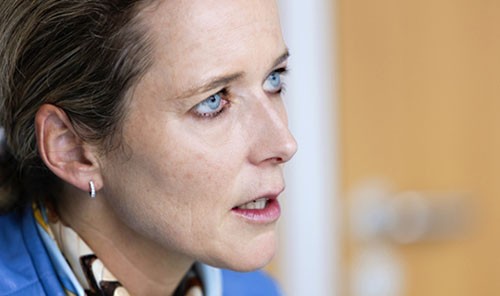Interview with Barbara Josef, 5to9 partner
“Change management is not enough”
Digitisation requires a reorganisation of work and hierarchies. New work transformation demands completely new approaches. Barbara Josef discusses the opportunities and risks for companies.
Texts: Hansjörg Honegger, Images: Raphael Zubler, 25 October 2017
Barbara Josef, companies now not only have to drive forward digital transformation, which is already difficult enough, but should also be implementing the new work transformation. Is this just another example of much ado about nothing?
(Laughs) That’s a good expression and unfortunately that’s often the case. But with the new work transformation, just like the digital transformation, the focus has to be on the meaning, not the buzzword. What needs to be changed, which benefits does agility bring, what effect does it have on customers? The most important question to ask is: how can we make the change authentic: take a step forwards without losing employees?
Are the usual change management processes not enough?
No, you can’t achieve that with our previous understanding of change management. Up until now, the organisation has been transformed from a known initial state A into a known target state B, by means of communication and training. However, current changes are so profound and complex that everyone needs to think and act together. This often stands in stark contrast to how corporate culture functioned previously, whereby employees had little autonomy and scope for action.
Can you briefly explain what it is we’re talking about here? What exactly is new work transformation?
We’re talking about four types of flexibility. In many companies, only two of these are practised, if any: On the one hand, there’s time flexibility. I still measure the total number of performed hours, but I can distribute these myself. Spatial flexibility is also clear; I can combine this with time flexibility. The other two factors will keep us busier; there isn’t yet much of a focus on them.
And these are?
Structural flexibility. How is the company set up? Can certain departments function with self-organisation and others not, for example? The fourth point is contractual flexibility. Lots of people work on an assignment basis for various companies and are no longer permanently employed. We need to find solutions for this that are also socially viable and that don’t negatively impact a specific group of people. New work transformation is about these four factors.
Where can action be taken in order to change something?
Put simply, the three areas are people, spaces and technologies. With people, it’s about leadership and work culture, as well as the underlying values. With technologies, it’s about the tools that are used for communication and sharing knowledge. By spaces, we mean the infrastructure: which work scenarios are available for various activities and requirements – inside and outside the office?
Barbara Josef
From February 2008 to November 2015, Barbara Josef was Head of Communication and a member of the Management Board at Microsoft Switzerland, and from July 2013 she was also responsible for the company commitment. Before this she fulfilled a variety of roles in marketing and communication at Helsana and Swiss International Airlines. In January 2016 she co-founded the consulting firm 5to9, of which she is also a partner.
«However, the declaration of intent to seriously address and change things needs to come from the Management Board. »
Barbara Josef, 5to9 partner
Digital transformation is often driven forward by IT or business requirements. Who needs to drive forward, or at least stimulate, the new work transformation?
Modern technologies enable a different form of collaboration, and younger generations are also calling for this. However, the declaration of intent to seriously address and change things needs to come from the Management Board. In the first phase of the digital transformation, we tried to make the existing processes and systems quicker, better and more efficient. The next phase is about finding entirely new solutions, scenarios and attitudes. Correspondingly, the transformation needs to be coordinated closely with the corporate strategy and development.
Is HR not enough?
Flexibility of working hours, for example, often resides with HR. However, that’s doomed to failure. Not because the HR managers wouldn’t be able to do it, but because it sends the wrong signals. If the HR Managers drive the topic forward, it’s often interpreted as protection of marginalised groups, such as women and men with children, or as a wellness option. Greater flexibility is not an employee perk. Instead, it’s much more about the transformation towards a culture that is characterised by greater autonomy, which is the prerequisite for being able to deal with the transformation and the associated uncertainty.
Why is that?
We need a cultural change that will help get employees back on board. They need to think proactively as opposed to simply performing.
Such transformations are often trigged unintentionally: sometimes a great communication tool or open-plan office is introduced because it’s cheaper. And suddenly you end up confronted with the call for a cultural change.
Yes, I see it like that too. Greater flexibility of working hours has become a trend and often entails reorganisation of the office environment. In this case, the trigger is often the facility managers. The IT department also triggers change by introducing a new tool. These employees often subsequently end up frustrated, because the tools aren’t used as intended.

So it would be better the other way round?
Yes; first of all, the corporate culture needs to be scrutinised on the basis of the corporate strategy and the differentiation towards employees. Only then should people start discussing technology and spaces.
How does the company benefit?
A better question would be: how do the company and the individual benefit? As the boss, I need satisfied, motivated people who give their best. These employees will go the extra mile in critical moments, and they think for themselves. They should feel more like entrepreneurs than employees.
That’s still a long way off yet.
I disagree. Research clearly shows that people in whom trust is placed will repay that trust with a high level of commitment.
But that has nothing to do with digitisation. In the 1980s, I would have also been happy to be treated in that way.
That’s right, lots of things are wrapped up in digitisation nowadays. But new technologies now enable a much higher level of autonomy. We are a lot more mobile and are able to share our knowledge a lot more effectively.
« You shouldn’t spend a long time in advance thinking about what impact a change could have, but just go ahead and do it step by step »
Barbara Josef, 5to9 partner
Let’s be specific: the cultural change requires all levels of management to hand over influence and power. How do you implement this type of cultural change?
The topics of power and loss of control are key. But you need to be careful not to have unrealistic expectations. First of all, you need to find cells in the business that need to work more quickly and with greater agility. When reorganising these departments, you should experiment, try out prototypes and not worry about re-discussing decisions that have already been made. You shouldn’t spend a long time in advance thinking about what impact a change could have, but just go ahead and do it step by step. There are always plenty of volunteers who are keen on change and don’t perceive it as a threat. For one, this process facilities faster learning; for another, it enables you to find out about the acceptance of a new idea – that is to say, what needs to be taken into consideration with regard to the corporate culture and values.
Could these experiments also have an impact on the rest of the company?
Of course, that’s the whole point. The rest of the workforce senses that something is changing – ideally for the better – without having to take part in it directly.
What about people who are not willing or able to deal with the new general conditions?
Changes often bring problems that were already there to the surface. For example, if someone hasn’t identified with an organisation for a long time and doesn’t see the point of their work. You already need to deal with such people, including in the interests of the other team members. But it’s necessary to look into the reasons for the resistance. With usual change management, the aim is often a change that is as smooth and efficient as possible, without opposition. I think that’s a mistake.
Why is that? Efficiency is important, isn’t it?
Resistance is often guarding something important. You need to ask: what is worth guarding? Interestingly, it’s usually non-monetary things: values, rituals and traditions. That’s why the question of common values should be central to every transformation process: what has made us successful up until now? What does our team have in common? What do we want to keep the way?
Ultimately, the whole discussion is rather elitist. The majority of employees won’t benefit from it.
I disagree. Everyone can benefit from a dialogue on an equal footing and greater autonomy in the organisation of work. Autonomy is a huge driver for motivation, regardless of the actual content of the work. Of course, some of the changes mentioned primarily affect knowledge work. But we’re not talking about a minority here either. In Switzerland, 43 % of the 5.4 million employed people have a knowledge-intensive occupation. That’s the highest percentage all over the world. With annual job growth of almost 20 % in this field, it will become even more important for our national economy in years to come. It’s therefore worth thinking about the topic “home office.”

The HR department is ultimately the crux of the entire process. Are the HR professionals aware of this?
Most HR managers are more “caretakers” than drivers of innovation. As a result, they often become involved in discussions at the later stages, which is a great shame. HR managers need to reposition themselves: they should actively advise line managers and supervise change processes. That, together with active community and public relations, will be the most important raison d'être for HR in future. Everything else, it is possible to automate or outsource.
To conclude, can you provide three specific tips as to how a company director can approach the new work transformation?
To start with, the strategy should be linked with the discussion of values. Which culture and which attitude enable us to go in the desired direction? Insofar as the approach is concerned, it’s a question of “doing before studying”: take the plunge by way of experimenting. These learning fields shouldn’t be artificial; working together on real challenges across teams is most effective in terms of motivation and makes the most sense. The third point is to take a close look at the signals that are being sent both explicitly and implicitly in an organisation and to check whether they support or hinder the implementation of the target. This isn’t just about the behaviour of the managers, but about that of the employees too.
Speaking from experience, the discussion of values leads to a set of ten guiding principles, which ultimately end up gathering dust. Everyone’s experienced that at some point. How do you prevent that from happening?
On the one hand, by drawing them up in a participatory process, and on the other by applying them consistently, thereby bringing them to life. If a company makes openness and curiosity a priority, for example, this influences the premises, the technologies used and the leadership and incentive systems. Ideally, the focus needs to be not on communicating the values, but instead on using them as the basis for all decisions and for setting the agenda. That’s also the only successful way of dealing with the loss of control. Values that are shared and practised instead of rigid rules that smother any spark of individual responsibility and motivation.
Swisscom offers a wide range of products and services that enable new, smart ways of working. Our Work Smart Coaches are happy to advise you and show you what new work transformation can mean for your organisation.

Newsletter
Would you like to regularly receive interesting articles and whitepapers on current ICT topics?
More on the topic

